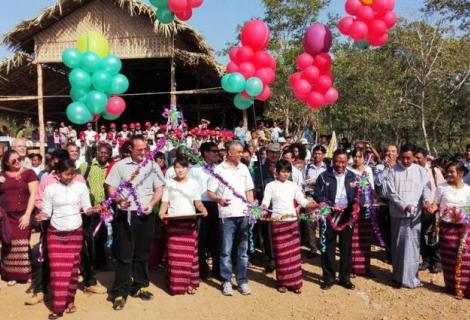Community-based tourism is open for business

ActionAid Myanmar is pleased to announce that its exciting new community-based tourism initiative is now underway. The initiative represents the culmination of years of fruitful engagement with the communities we work with combined with high-level dialogue and engagement with the Ministry of Hotels and Tourism.
After a much-publicised opening ceremony on 30 November, Journeys Adventure Travel (in partnership with ActionAid Myanmar) began taking small groups of tourists visiting the Bagan area on exclusive two-day adventure tours of villages in nearby Myaing.
Guests are housed in local-style accommodations adjacent to the villages, and during their stays have multiple opportunities to experience the area’s beautiful ecosystem, participate in cultural exchanges, and experience village life.
The tour is billed as adventure travel and targeted towards Intrepid Travel guests who wish to “get off the beaten path” and experience the true local culture that exists outside commercialised tourist routes.
The overall goal of the project is to establish a tourism destination in Myaing Township that is minimally disruptive to the local environment and existing way of life in local communities, but also allows for increased economic opportunities in a manner that is sustainable, community driven, and implemented in a manner that benefits the wider community as a whole.
As such, the initiative embodies both ActionAid’s human-rights based approach and the inventive, entrepreneurial vision for which ActionAid Myanmar has become known. The specific objectives of the project are to foster alternative livelihoods opportunities by providing hospitality skills training and employing interested community members, to benefit the wider community by creating a community fund in which a portion of tourism revenues can be used to fund community-wide development projects, and to create a model that can be replicated for use in future community-based tourism initiatives throughout Myanmar.
Myanmar is a rapidly emerging tourism destination in Southeast Asia, with the tourism industry consistently proving itself to be a driver for growth in the country’s developing economy. For the first time in its history, the country received over 1 million international visitors in 2012, an increase in over 30% compared to visitors in 2011. Tourism income rose from 319 million USD in 2011 to 534 million USD in 2012.
Growth has only continued since then, with Ministry of Hotels and Tourism data showing 2014 to be another record-breaking year, with 3.5 million visitors and 1.135 billion USD in revenue. 4-5 million tourist arrivals are expected for the year 2015, and as such both government and private sector actors are searching for ways to expand tourist destinations in Myanmar.
The economic gains from tourism have been significant, but they have not been widespread. Much of the benefit has been concentrated within the current core group of established tourism hubs such as Yangon, Mandalay, Bagan and Inle Lake.
Myaing Township is just a 30 minute drive from Bagan, yet it experiences virtually none of the benefits of the burgeoning tourism industry. Job opportunities are limited in Myaing, and severe poverty is common. Most villagers work as farmers and unskilled labourers, and it is common for youth and working-age adults to migrate elsewhere within Myanmar or abroad in search of work.
The average daily income is 800 - 2,000 Myanmar kyat per day. Community members have often expressed their desire to find a way to benefit from the influx of tourism revenue in nearby Bagan.
The concept of community involvement in tourism is understandably gaining popularity in the international development field, given the ease of which tourism can add wealth to communities, diversify local economies, and offer alternative livelihoods opportunities and job skills in a growing economic sector.
Given the close proximity of the Bagan tourism market, the desire of Myaing villagers to capitalise on that market, and the desires of government and private tourism industry stakeholders to expand tourism destinations to new areas, establishing a community-based tourism project is a logical and viable avenue for fostering alternative livelihoods in the Myaing area.